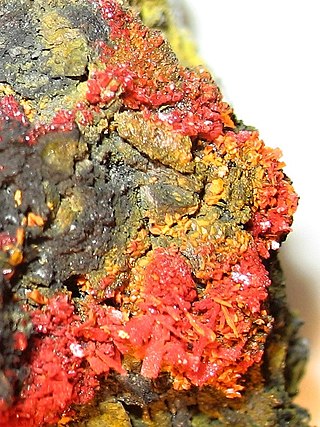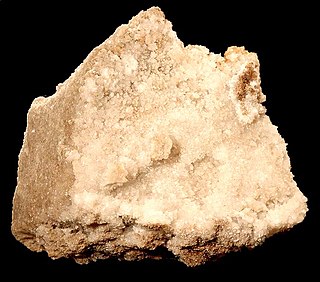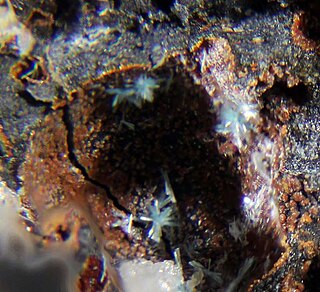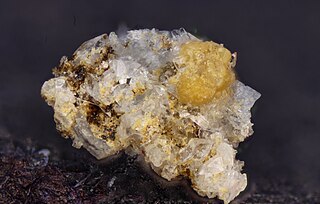Related Research Articles

Stilbite is the name of a series of tectosilicate minerals of the zeolite group. Prior to 1997, stilbite was recognized as a mineral species, but a reclassification in 1997 by the International Mineralogical Association changed it to a series name, with the mineral species being named:

Alstonite, also known as bromlite, is a low temperature hydrothermal mineral that is a rare double carbonate of calcium and barium with the formula BaCa(CO
3)
2, sometimes with some strontium. Barytocalcite and paralstonite have the same formula but different structures, so these three minerals are said to be trimorphous. Alstonite is triclinic but barytocalcite is monoclinic and paralstonite is trigonal. The species was named Bromlite by Thomas Thomson in 1837 after the Bromley-Hill mine, and alstonite by August Breithaupt of the Freiberg Mining Academy in 1841, after Alston, Cumbria, the base of operations of the mineral dealer from whom the first samples were obtained by Thomson in 1834. Both of these names have been in common use.

Zanazziite is a complex hydrated phosphate mineral from the roscherite group. It is a magnesium beryllium phosphate mineral. Zanazziite arises as barrel-shaped crystals and can reach up to 4 mm. It grows alongside quartz minerals. It is found in the crevices of Lavra da Ilha pegmatite, near Taquaral, in northeastern Minas Gerais, Brazil. Zanazziite is named after Pier F. Zanazzi. Zanazziite has an ideal chemical formula of Ca2Mg5Be4(PO4)6(OH)4·6H2O.

Alacránite (As8S9) is an arsenic sulfide mineral first discovered in the Uzon caldera, Kamchatka, Russia. It was named for its occurrence in the Alacrán silver/arsenic/antimony mine. Pampa Larga, Chile. It is generally more rare than realgar and orpiment. Its origin is hydrothermal. It occurs as subhedral to euhedral tabular orange to pale gray crystals that are transparent to translucent. It has a yellow-orange streak with a hardness of 1.5. It crystallizes in the monoclinic crystal system. It occurs with realgar and uzonite as flattened and prismatic grains up to 0.5 mm across.
Bityite is considered a rare mineral, and it is an endmember to the margarite mica sub-group found within the phyllosilicate group. The mineral was first described by Antoine François Alfred Lacroix in 1908, and later its chemical composition was concluded by Professor Hugo Strunz. Bityite has a close association with beryl, and it generally crystallizes in pseudomorphs after it, or in cavities associated with reformed beryl crystals. The mineral is considered a late-stage constituent in lithium bearing pegmatites, and has only been encountered in a few localities throughout the world. The mineral was named by Lacroix after Mt. Bity, Madagascar from where it was first discovered.
Coyoteite is a hydrated sodium iron sulfide mineral. The mineral was named coyoteite after Coyote Peak near Orick, California, where it was discovered.

Talmessite is a hydrated calcium magnesium arsenate, often with significant amounts of cobalt or nickel. It was named in 1960 for the type locality, the Talmessi mine, Anarak district, Iran. It forms a series with β-Roselite, where cobalt replaces some of the magnesium, and with gaitite, where zinc replaces the magnesium. All these minerals are members of the fairfieldite group. Talmessite is dimorphic with wendwilsonite.
Scandiobabingtonite was first discovered in the Montecatini granite quarry near Baveno, Italy in a pegmatite cavity. Though found in pegmatites, the crystals of scandiobabingtonite are sub-millimeter sized, and are tabular shaped. Scandiobabingtonite was the sixth naturally occurring mineral discovered with the rare earth element scandium, and grows around babingtonite, with which it is isostructural, hence the namesake. It is also referred to as scandian babingtonite. The ideal chemical formula for scandiobabingtonite is Ca2(Fe2+,Mn)ScSi5O14(OH).
Metarauchite is a member of the autunite group, found at the Jáchymov ore district, Czech Republic and in Schneeberg, Germany. The autunite group is a group of structured uranyl phosphates and arsenates; the other members of the group are autunite, bassetite, heinrichite, kahlerite, nováčekite-I, nováčekite-II, rauchite, sabugalite, saléeite, torbernite, uranocircite, uranospinite, and zeunerite. The mineral is named after Czech mineral collector Luděk Rauch, who died in the Jáchymov mines during mineral prospecting.
Scotlandite is a sulfite mineral first discovered in a mine at Leadhills in South Lanarkshire, Scotland, an area known to mineralogists and geologists for its wide range of different mineral species found in the veins that lie deep in the mine shafts. This specific mineral is found in the Susanna vein of Leadhills, where the crystals are formed as chisel-shaped or bladed. Scotlandite was actually the first naturally occurring sulfite, which has the ideal chemical formula of PbSO3. The mineral has been approved by the Commission on New Minerals and Mineral Names, IMA, to be named scotlandite for Scotland.

Mammothite is a mineral found in the Mammoth mine in Tiger, Arizona and also in Laurium, Attika, Greece. This mineral was named in 1985 by Donald R. Peacor, Pete J. Dunn, G. Schnorrer-Köhler, and Richard A. Bideaux, for the Mammoth vein (one of the two main veins in the mine) and the town of Mammoth, Arizona, which was named for the mine. The mammothite that is found in Arizona exist as euhedral crystals imbedded in micro granular, white colored anglesite with a saccharoidal texture. The associated minerals include phosgenite, wulfenite, leadhillite and caledonite. In Greece, the mammothite exists as small euhedral crystals and also as microscopic rock cavities lined with projecting crystals within the slags. The associated minerals here are cerussite, phosgenite and matlockite. The ideal chemical formula for mammothite is Pb6Cu4AlSb5+O2(OH)16Cl4(SO4)2.

Zigrasite is a phosphate mineral with the chemical formula of MgZr(PO4)2(H2O)4. Zigrasite was discovered and is only known to occur in the Dunton Quarry at Oxford County, Maine. Zigrasite was specifically found in the giant 1972 gem tourmaline-bearing pocket at the Dunton Quarry. Zigrasite is named after James Zigras who originally discovered and brought the mineral to attention.

Serrabrancaite is a mineral with the chemical formula MnPO4•H2O and which is named for the locality where it was found, the Alto Serra Branca Pegmatite. The Alto Serra Branca mine has been in operation since the 1940s. It is located in Paraiba, Brazil near a village named Pedra Lavrada. Tantalite is the main mineral mined here. Specimens of serrabrancaite are kept in the Mineralogical Collections of both the Bergakademie Freiberg, Germany and the Martin-Luther Universität Halle, Institut für Geologische Wissenschaften.
Cattiite is a phosphate mineral. The mineral was first found in a veins of dolomite carbonatites veins at the bottom of the Zhelezny (Iron) Mine in the Kovdor massif, Kola Peninsula, Russia. Cattiite was tentatively identified as Mg3(PO4)2·22H2O, which as a high hydrate magnesium orthophosphate. Later structural studies, revealed the existence of two polytypes named Mg3(PO4)2·22H2O-1A1 and Mg3(PO4)2·22H2O-1A2.

Lomonosovite is a phosphate–silicate mineral with the idealized formula Na10Ti4(Si2O7)2(PO4)2O4 early Na5Ti2(Si2O7)(PO4)O2 or Na2Ti2Si2O9*Na3PO4.
Falcondoite, a member of the sepiolite group, was first discovered in the Dominican Republic, near the town of Bonao. The mineral was found in a deposit mined by Falconbridge Dominica, and so was named "falcondoite" after the company. Falcondoite is frequently associated with sepiolite, garnierite, talc, and serpentine, and is commonly nickel-bearing. While the chemical formula for falcondoite can vary, the mineral must contain more nickel than magnesium to be considered its own species. The ideal chemical formula for falcondoite is (Ni,Mg)4Si6O15(OH)2·6H2O.
Chukanovite is an iron(II) hydroxide-carbonate mineral with the ideal chemical formula Fe+22(CO3)(OH)2. It is a member of the rosasite mineral group and crystalizes in the monoclinic crystal system. Upon initial crystallization, it is typically pale green to colorless, but it takes on a brownish green hue after being altered at the surface. As a weathering product of meteoritic iron, chukanovite is a relatively uncommon mineral on Earth, having only been discovered in the year 2000. However, it is commonly formed artificially as a corrosion byproduct through the manufacturing of sand-deposited carbon steel.

Edoylerite is a rare mercury-containing mineral. Edoylerite was first discovered in 1961 by Edward H. Oyler, whom the mineral is named after, in a meter-sized boulder at the Clear Creek claim in San Benito County, California. The Clear Creek claim is located near the abandoned Clear Creek mercury mine. The material from the boulder underwent several analyses including, X-ray powder diffraction (XRD), a single crystal study, and a preliminary electron microprobe analysis (EMA). Using these analyses it was determined that this was a new mineral but the nature of the material at the time prevented further investigation. It was not until 1986, with the discovery of crystals large enough for a crystal structure determination and a sufficient quantity for a full mineralogical characterization, that the study was renewed. The new edoylerite crystals were found in the same area at the Clear Creek claim but were situated in an outcrop of silica-carbonate rock. This silica-carbonate rock was mineralized by cinnabar following the hydrothermal alteration of the serpentinite in the rock. Edoylerite is a primary alteration product of cinnabar. Though found with cinnabar, the crystals of edoylerite do not typically exceed 0.5mm in length. The ideal chemical formula for edoylerite is Hg32+Cr6+O4S2
Ransomite is a sulfate mineral first discovered at the United Verde mine in Jerome Arizona. This mineral was formed as a result of a mine fire. The United Verde mine is one of few places in the world where Ransomite can be found. This mineral can be described as a soluble sulfate that forms needle-like crystals and has a pale blue color in transmitted light. This mineral was named by Carl B. Lausen as a tribute to Frederick Leslie Ransome. Ransome was an American mining geologist who worked at the California Institute of Technology, the University of Arizona and the United states Geological Survey.
Ophirite is a tungstate mineral first discovered in the Ophir Hill Consolidated mine at Ophir district, Oquirrh Mountains, Tooele County, Utah, United States of America. It was found underground near a calcite cave in one veinlet, six centimeters wide by one meter long, surrounded by different sulfides. Before the closing of the mine in 1972, it was dominated by sulfide minerals, and the Ophir district was known for being a source of zinc, copper, silver, and lead ores. The crystals are formed as tablets. It is the first known mineral to contain a heteropolyanion, a lacunary defect derivative of the Keggin anion. The chemical formula of ophirite is Ca2Mg4[Zn2Mn3+2(H2O)2(Fe3+W9O34)2] · 46•H2O. The mineral has been approved by the Commission on New Minerals and Mineral Names, IMA, to be named ophirite for its type locality, the Ophir Consolidated mine.
References
- ↑ Warr, L.N. (2021). "IMA–CNMNC approved mineral symbols". Mineralogical Magazine. 85 (3): 291–320. Bibcode:2021MinM...85..291W. doi: 10.1180/mgm.2021.43 . S2CID 235729616.
- 1 2 3 4 5 6 7 8 Chukanov, N. V., et al., 2013, Lahnsteinite, Zn4(SO4)(OH)6 ⋅ 3H2O, a New Mineral from the Friedrichssegen Mine, Germany: Geology of Ore Deposits, v.55 p.663-668.
- ↑ Hudson Institute of Mineralogy, 2017, Lahnsteinite:https://www.mindat.org/min-42746.html Archived 2017-12-24 at the Wayback Machine (accessed November 2017)